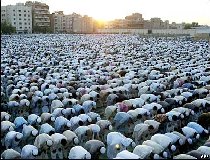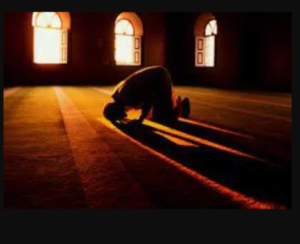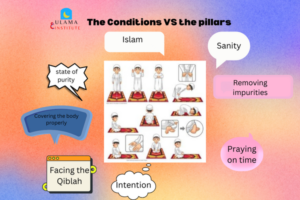
How to perform the ‘Eed Prayers
Time of the ‘Eed Prayers The ‘Eed Prayer khutbah
Ulama Institute #1
Looking to learn Arabic or memorize the Quran?
Check our Trusted Teachers

The ‘Eed prayers present an excellent opportunity for the servants of Allah to give thanks and appreciation to Allah ﷻ for granting them the ability to fast and perform the Hajj. There are two ‘Eed celebrations that occur every year, ‘Eed Al-Fitr and ‘Eed Al-Ad-haa. Both of these days of celebration begin with the worship of Allah ﷻ . On the day of ‘Eed, when the sun has risen to a point which is approximately one spear length above the horizon, the Muslims perform the ‘Eed prayer.
It was from the practice of the Prophet ﷺ to perform the ‘Eed prayer at an earlier time on the ‘Eed of sacrifice to ensure that the Muslims would be afforded a sufficient amount of time to slaughter their sacrificial animals. It was also from the practice of the Prophet ﷺ to delay the prayer on the ‘Eed of fast-breaking to ensure that the Muslims were able to distribute their Zakah.
The ‘Eed prayers consist of two raka’aat which are offered without an adhaan or an iqaamah. These prayers are recited aloud like the Jumu’ah prayer. In the first rak’ah, after performing takbeeratul-ihraam but before the recitation of the Qur’aan, the praying person says “Allahu Akbar” six times before reciting any Qur’aan. Then in the second rak’ah, after saying “Allahu Akbar” to indicate a change in position, the praying person says “Allahu Akbar” again five times while raising his hands for each pronouncement. The praying person should then glorify Allah and praise Him and confer blessings upon the Prophet ﷺ between each statement of “Allahu Akbar”.
It is from the Sunnah of the Prophet ﷺ to recite Soorat al-Alaa in the first rak’ah of prayer and Soorat al-Ghaashiyyah in the second as found in the narration of Nu’maan ibn Basheer who states that:
أَنْ رَسُولَ اللَّهِ صَلَّى اللَّهُ عَلَيْهِ وَسَلَّمَ كَانَ يَقْرَأُ فِي الْعِيدَيْنِ بِسَبِّحِ اسْمَ رَبِّكَ الْأَعْلَى وَهَلْ أَتَاكَ حَدِيثُ الْغَاشِيَةِ ” (مسلم)
“The Messenger of Allah used to recite during the two ‘Eed prayers; Soorat al-A’laa and Soorat al-Ghaashiyyah.” (Muslim)
It has also been reported that the Prophet ﷺ used to recite Soorat Qaaf in the first raka’ah of prayer and Soorat Al-Qamar in the second.
Once the imaam completes his prayer, he will immediately ascend the minbar and deliver two short khutbahs. After completing the first khutbah, the imaam will sit momentarily before proceeding with the second khutbah. It has been narrated that the Prophet ﷺ would deliver the khutbah while standing. He would then sit for a while and stand again to complete the khutbah.
It is recommended that the imaam bases his khutbah upon issues and matters that are directly relevant to the community he is addressing. He may choose to address the issue of zakah distribution when he gives the khutbah on ‘Eed Al-Fitr or may explain the rulings concerning slaughtering sacrificial animals when he gives the khutbah on ‘Eed Al-Ad-haa.
Women are encouraged to perform the ‘Eed prayer and listen to the imaam’s khutbah. For this reason, the imaam should be sure to direct part of his ‘Eed khutbah to the women in attendance. We understand this from the Prophet’s ﷺ admonition to the women on the day of ‘Eed. When he learned that the women could not hear the khutbah because they were seated far away from him, he went to them and admonished them and encouraged them to give charity.
The performance of supererogatory prayers before or after the ‘Eed prayers is strongly disliked. This position is based upon the narration of Ibn ‘Abbaas who said:
أَنَّ النَّبِيِّ صَلَّى اللهُ عَلَيْهِ وَسَلَّمَ خَرَجَ يَوْمَ الْفِطْرِ فَصَلَّى رَكْعَتَيْنِ لَم يُصَلِّ قَبْلَهَا وَلَا بَعْدَهَا وَمَعَهُ بِلَالٌ. (البخاري)
“The Prophet ﷺ left (his home) on the day of fast-breaking. Shortly thereafter he prayed two rak’aat of prayer without praying anything before it or after it. And he was accompanied by Bilal.” (Al-Bukhaan)
There is no harm in performing prayer when one returns home from the ‘Eed prayer. We understand this from the narration of Imaam Ahmad which states that the Prophet ﷺ prayed two rak’aat of prayer at home after the ‘Eed prayer.
Learning from the lesson
- The ‘Eed prayer consists of two rak’aat of prayer that are recited aloud.
- The ‘Eed prayer is followed by two short khutbahs which are given by the imaam.
- The performance of supererogatory prayers before or after the “Eed prayers is strongly disliked.







